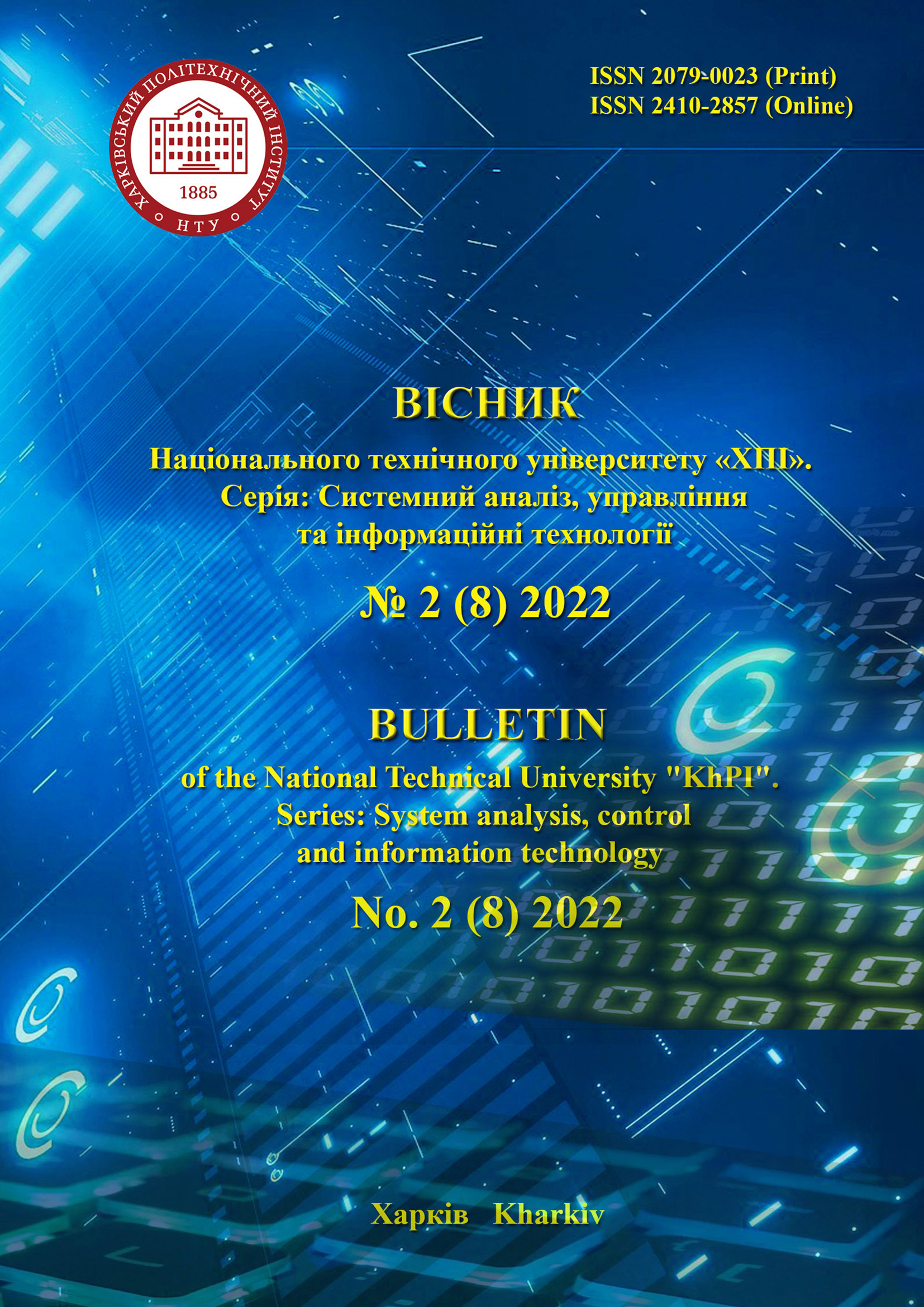APPLICATION OF CLUSTER ANALYSIS IN SMART GRID NETWORKS
DOI:
https://doi.org/10.20998/2079-0023.2022.02.05Keywords:
Smart Grid network, cluster analysis, quality of electric energy, expert system, classification problem, initial featuresAbstract
The task of developing and improving intelligent multi-agent control systems, which provide opportunities for intelligent online analysis of the electrical power supply system provided by the smart grid system, is considered. The purpose of the article is the formation of clusters of sections of the electrical network, the initial parameters of which are the main indicators of the quality of electrical energy in accordance with the accepted standards. Total harmonic distortion coefficient of voltages, coefficient of unsymmetry of supply voltages, reactive power of loads are chosen as such parameters. The results of the hierarchical clustering of power supply network sections are summarized in the corresponding dendogram. The method of full connection is used to form a dendogram of sections of the power supply system. This method defines the distance between clusters as the largest distance between any objects in different clusters or the most distant neighbors. The measure of closeness was determined by the Euclidean distance. The obtained treeshaped diagram demonstrates the distribution of the sections of the power supply system into four natural clusters, which visually divides the sections of the power supply system into separate groups according to certain characteristics, namely the main parameters of the quality of the power system. It is shown that the mathematical apparatus of cluster analysis allows solving the problem of classification of sections of the power supply system when the main parameters of the quality of electric energy deviate from the normally permissible values. It is proved that the classification can be carried out not only by one parameter, but also by using a combination of several parameters. The results of the conducted analysis provide an opportunity to further form production rules for the selection of measures to improve the quality of electric energy, which are applied to one or another section of the power supply system.)
References
Bagdadee A. H. Smart Grid: A Brief Assessment of the Smart Grid Technologies for Modern Power System. Journal of Engineering Technolog. 2019, vol. 8, pp. 122–142.
Melike E. K., Mouftah H. T. Energy-efficient information and communication infrastructures in the smart grid: a survey on interactions and open issues. IEEE Commun Surv Tutor. 2015, no. 17 (1), pp. 179–196.
Spanò E., Niccolini L., Pascoli S., Iannaccone G. Last meter smart grid embedded in an internet-of-things platform. IEEE Trans Smart Grid. 2015, no. 6 (1), pp. 468–75.
Benysek G., Kazmierkowski M. P., Popczyk J., Strzelecki R. Power electronic systems as a crucial part of Smart Grid infrastructure – a survey. Bulletin of the Polish Academy of Sciences. Technical Sciences. 2011, vol. 59, no. 4, pp. 455–473.
Denisyuk S. P., Stsheletskі R. Formuvannya skladovikh іntelektualnoї platformi keruvannya energetichnimi sistemami ta merezhami [Formation of components of an intelligent platform for managing energy systems and networks]. Energetika: ekonomіka. tekhnologії. ekologіya: naukoviy zhurnal [Energy: economy, technology, ecology: scientific journal]. 2019, no. 3 (57), pp. 7–22.
Gavrilova T. A. Khoroshevskiy V. F. Bazy znaniy intellektualnykh system [Knowledge bases of intelligent systems]. Saint Petersburg, Piter Publ., 2000. 384 p.
Gpigopev A. A. Klasternyy analiz kak instrument obrabotki dannykh pri analize informatsionnykh system [Cluster analysis as a data processing tool in the analysis of information systems]. Izvestiya rossiyskogo ekonomicheskogo universiteta im. G. V. Plekhanova [Proceedings of the Russian University of Economics after G. V. Plekhanov]. 2013, no. 1 (11), pp. 36–48.
Barsegyan A. A., Kupriyanov M. S., Stepanenko V. V., Kholod I. I. Metody i modeli analiza dannykh: OLAP i Data Mining. [Methods and models of data analysis: OLAP and DataMining]. Saint Petersburg, BHV-Peterburg Publ., 2004. 336 p.
Volosyuk Yu. V. Analіz algoritmіv klasterizatsії dlya zadach ntelektualnogo analіzu danikh [Analysis of clustering algorithms for data mining tasks]. Zbіrnik naukovikh prats Vіyskovogo іnstitutu Kiivskogo natsіonalnogo unіversitetu іm. Tarasa Shevchenka. [Collection of scientific works of the Military Institute of Kyiv National University named after Taras Shevchenko]. 2014, no. 47, pp. 112–119.
Gulak D. Using cluster analysis for research of Ukrainian electricity market. The scientific heritage (Budapest). 2017, no. 10 (10), pp. 23– 26.
Mandel I. D. Klasternyy analіz [Cluster analysis]. Moscow, Finansy i statistika Publ., 1988. 176 p.
GOST 13109-97. Elektricheskaya energiya. Sovmestimost tehnicheskih sredstv elektromagnitnaya. Normy kachestva elektricheskoj energii v sistemah elektrosnabzheniya obshego naznacheniya [Electric Energy. Compatibility of technical means is electromagnetic. Standards for the quality of electrical energy in general-purpose power supply systems]. Moscow, IPK Izdatelstvo standartov Publ., 1998. 35p.
Stukach O. V. Programmnyy kompleks STATISTICA v reshenii zadach upravleniya kachestvom: uchebnoye posobiye [Program complex STATISTICA in solving problems of quality management: a tutorial.]. Tomsk, Izdatelstvo Tomskogo politekhnicheskogo universiteta Publ., 2011. 16 p.
Bureyeva N. N. Mnogomernyy statisticheskiy analiz s ispolzovaniyem PPP “STATISTICA”. Uchebno-metodicheskiy material po programme povysheniya kvalifikatsii «Primeneniye programmnykh sredstv v nauchnykh issledovaniyakh i prepodavanii matematiki i mekhaniki» [Multivariate statistical analysis using STATISTICA AP. Educational and methodological material for the advanced training program "Application of software in scientific research and teaching of mathematics and mechanics"]. Nizhny Novgorod, 2007. 112 p.
Downloads
Published
How to Cite
Issue
Section
License
LicenseAuthors who publish with this journal agree to the following terms:
- Authors retain copyright and grant the journal right of first publication with the work simultaneously licensed under a Creative Commons Attribution License that allows others to share the work with an acknowledgement of the work's authorship and initial publication in this journal.
- Authors are able to enter into separate, additional contractual arrangements for the non-exclusive distribution of the journal's published version of the work (e.g., post it to an institutional repository or publish it in a book), with an acknowledgement of its initial publication in this journal.
- Authors are permitted and encouraged to post their work online (e.g., in institutional repositories or on their website) prior to and during the submission process, as it can lead to productive exchanges, as well as earlier and greater citation of published work (See The Effect of Open Access).


